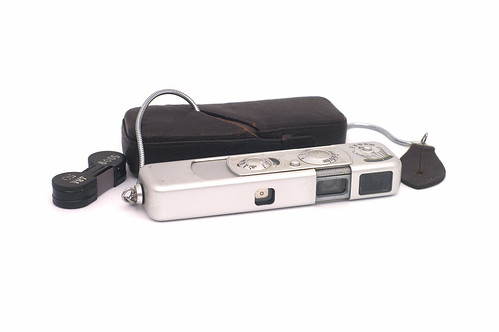Difference between revisions of "Subminiature"
m (Punct.) |
(→External links) |
||
| Line 29: | Line 29: | ||
* [http://www.submin.com Submin.com] | * [http://www.submin.com Submin.com] | ||
* [http://www.butkus.org/chinon Location] of Minox instruction manuals, Minolta 16mm and a few other brands | * [http://www.butkus.org/chinon Location] of Minox instruction manuals, Minolta 16mm and a few other brands | ||
| + | * [http://www.ritzcam.com/catalog/index.php?category_id=630/ Buy Subminiatures Online] | ||
[[Category: Film formats]] | [[Category: Film formats]] | ||
[[Category: Subminiature|*]] | [[Category: Subminiature|*]] | ||
Revision as of 18:31, 11 February 2008

|
| Minox B, made from 1958 to 1971 |
At the beginning of photography, a film format of 9x12cm or 4x5in was considered normal, so the first cameras using the 35mm film were called miniature cameras. This is why all the cameras with a smaller format have been called subminiature cameras. There was a huge variety of formats, mainly on 16mm and 9.5mm film. The most representative camera is the Minox 9.5mm.
Some people consider the 18x24mm format (half-frame format) as subminiature. The real half film format was 17.5 mm, very popular after WWII in Japan. The leading camera type for that format was the Hit. The Hit cameras were copied by dozens of camera makers.

|
| A Hong Kong-made copy of the Japanese Hit |

|
| Kodak camera for Type No. 110 16mm film cartridges, the most popular subminiature film variant |
Links
- Category: Subminiature cameras
External links
- Subclub
- Submin.com
- Location of Minox instruction manuals, Minolta 16mm and a few other brands
- Buy Subminiatures Online